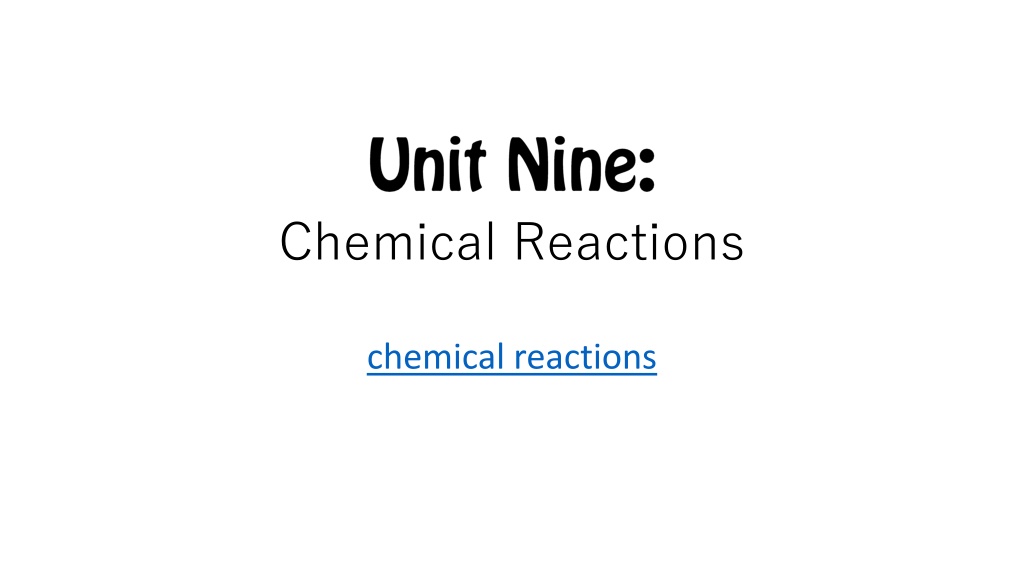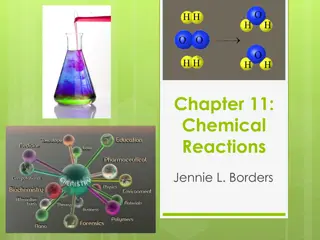Understanding Chemical Reactions in Daily Life
Understanding chemistry, particularly chemical reactions, is crucial for our daily lives. Chemical reactions involve the transformation of substances into different ones, described by reactants and products in equations. By learning about chemical equations, word equations, formula equations, and the balancing of reactions, we can grasp the essential principles underlying various reactions. Through examples like the reaction of iron with oxygen to form rust, we can see how reactants lead to specific products. Illustrations and explanations of reaction processes further enhance our comprehension of these fundamental chemical changes.
Download Presentation

Please find below an Image/Link to download the presentation.
The content on the website is provided AS IS for your information and personal use only. It may not be sold, licensed, or shared on other websites without obtaining consent from the author. Download presentation by click this link. If you encounter any issues during the download, it is possible that the publisher has removed the file from their server.
E N D
Presentation Transcript
Chemical Reactions chemical reactions
This is just one reason why understanding some chemistry is important to our daily lives. Ferric chloride (FeCl3) Nitric Acid (HNO3) Both are corrosive materials used to etch metal. Chemistry in the news: explosion in Spain
Chemical Reactions: A chemical reaction is the process by which one or more substances are changed into one or more different substances. In a chemical reaction, the original substances are called the reactant and the resulting substances are called the product. A chemical reaction is described by chemical equations. Basic Structure of a chemical reaction: Reactants Products
Chemical reactions can be written as word equations or as formula equations. Underline the reactant(s) and circle the product(s) in the following examples: Iron reacts with oxygen to produce iron oxide (rust). 2Fe(s) + O2(g) FeO(s) (Word equation) (Formula equation
Iron reacts with oxygen to produce iron oxide (rust). 2Fe(s) + O2(g) FeO(s) (Word equation) (Formula equation)
1. The reactants are always written to the left of the yield arrow () and the products are always written to the right. 2. Chemical formulas are still written using the criss-cross method. 3. Formula equations are balanced using coefficients which are written in front of the chemical formula.
Yield arrow (s) solid (l) liquid (g) gas (aq) Aqueous: water solution
Reactant(s) Products Pb(NO3)2(aq) + KI (aq) PbI2(s) + 2KNO3(aq) Lead iodide: ____________ Potassium iodide: ________ Potassium nitrate: ________ Lead nitrate : ___________
Pb (NO3)2(aq) + KI (aq) PbI2(s) + 2KNO3(aq) Lead iodide: Product Potassium iodide: Reactant Potassium nitrate: Product Lead nitrate : Reactant
There are five types of reaction that fit the following patterns: A + B AB 1. Synthesis 2. Decomposition 3. Single replacement 4. Double replacement AB + CD AD + CB 5. Combustion: CxHy+ O2 CO2+ H2O AB A + B A + BC AC + B
Types of reactions Types of reactions Pb(NO3)2(aq) + KI (aq) PbI2(s) + 2KNO3(aq) AB + CD AD + CB Double replacement!
Writing Chemical Reaction: Reactants : Lead(II) nitrate (aq) + Potassium iodide Products: Lead(II) iodide + Potassium nitrate Pb (NO3)2(aq) + KI (aq) ____________ + 2KNO3(aq) Your job: determine the formula and state of Lead (II) iodide Pb2+ = ________ I- = ___________ Formula = ____________
Since matter is neither created nor destroyed during a chemical reaction (Law of Conservation of Mass), it is necessary to balance the elements in a chemical equation. This is done using coefficients. Coefficients do not change the chemical formula but the do change the amount of each substance.
Remember this? 3H2O = ____ H, _____ O 2Al2(SO4)3 = ______ Al, _____S, ____ O
Answers 3H2O = 6 H, 3 O 2Al2(SO4)3 = 4 Al, 6 S, 24 O























